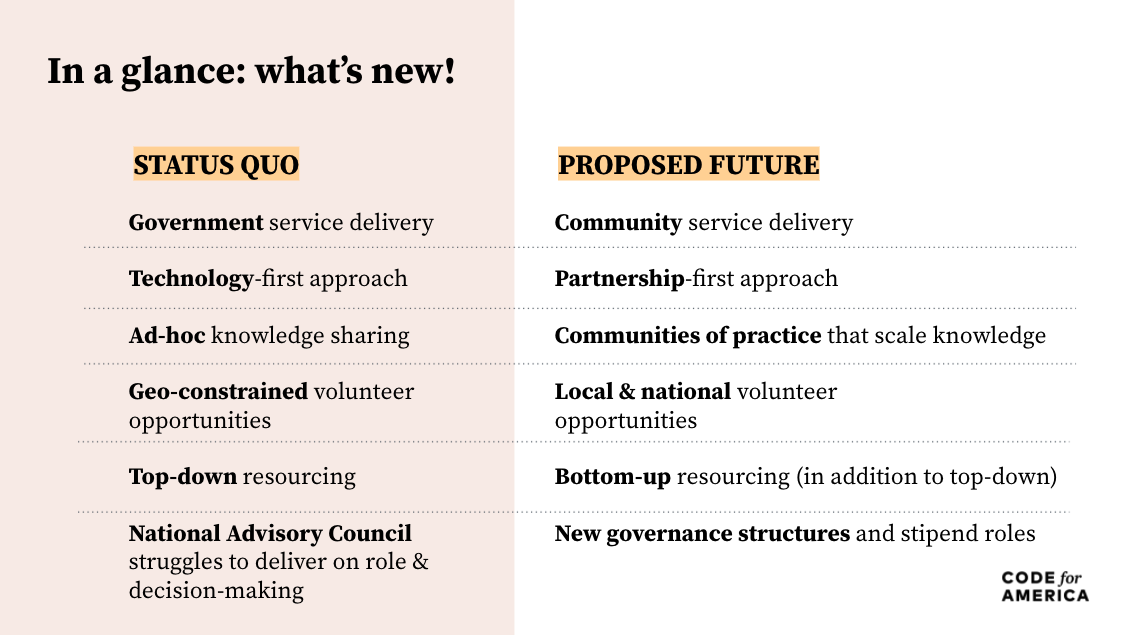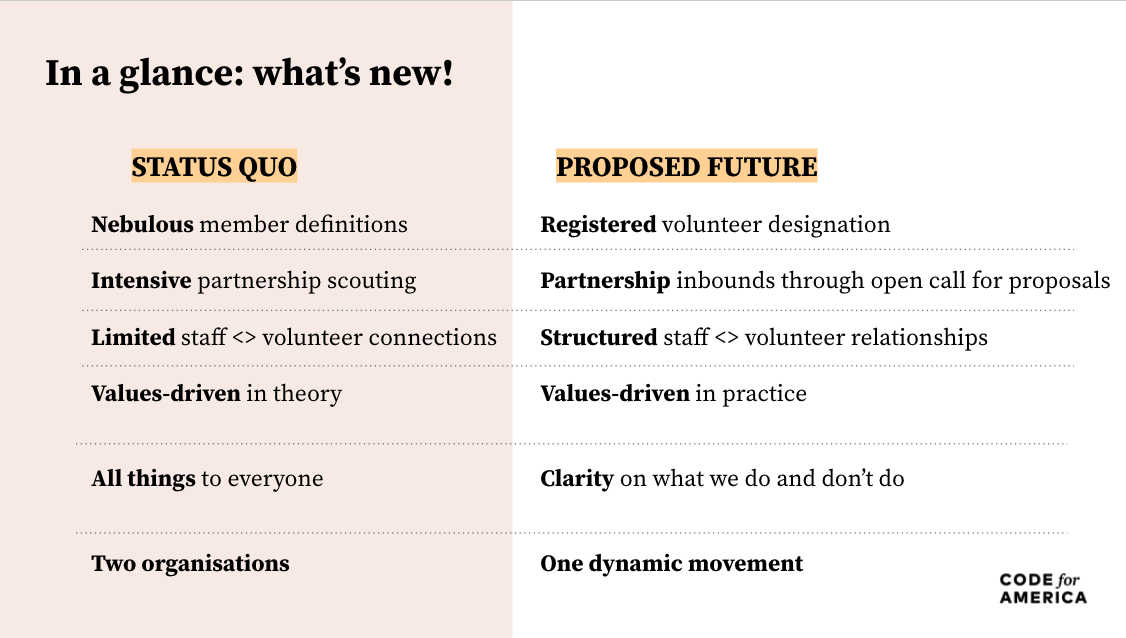The purpose of this post is to document and archive the ReVisioning Recommendation, previously stored in Gitbook. The last update to the actual text of the recommendation was made 11/5/21. One section of the original recommendation has been removed entitled “Feedback and Changelog” because the feedback portion of the recommendation is no longer applicable, and there will not be any further changes to this document. There will be separate posts to transfer the Recommendation, Methods and Findings sections of the recommendation due to Discourse’s character limit.
Network ReVisioning Project 1.0 Draft
This recommendation as drafted here is an extended and unabridged version of the recommendation memo which was received by Code for America CxO on August 4, 2021.
We anticipate that many members of the Brigade community will want to read the report in its entirety, so this format includes every part of the memo which was presented to CxO as well as extended resources like the raw and anonymized data from our surveys. Though the format is an extended one with an intention of sharing with Brigade leaders, the bulk of this memo itself is still drafted with Code for America leadership as the audience. You’ll notice this especially in the sections on resources and changes.
Executive Summary
If you want to get a quick glance at what’s being proposed with ReVisioning, this section can give you a simple overview.
This full draft of the Network’s ReVisioning Recommendation is necessarily long and detailed so that Code for America as an organization can develop the targeted support needed to sustain the change and transitions to its system that the draft describes.
This doesn’t make it easy reading for the busy Brigade member or non-Brigade volunteer. Here’s a quick rundown of our current experiences and what we hope can change or improve with the Recommendation’s implementation:


Where Do We Start Making Changes?
We start with developing better ways of relating to one another: nonprofit employee to Network volunteer, Brigade leader to member, Brigade members to non-Brigade volunteers, and our community to those we offer our tools and resources.
Our potential to negatively impact one another, to negatively impact communities we hope to help, can be lessened when we as a group exercise empathy in actionable, applicable ways. As a practice, small, guided group conversations develop this nuanced understanding of one another best.
The Network Team recently partnered with Tribeless, who host #EmpathyCircles, as a way of introducing this concept to the volunteer network. There isn’t a one-size-fits-all answer to how we build empathy as a skill, but that is one way to start.
The other way to involve yourself with empathy practices is through our own peer-to-peer team’s choices for connecting through conversation. Members of our Network can request time, or join the team to help how we develop this necessary part of our work together.
Introduction
Over the last 10 months, our Network community has asked big questions: What is our role in the world? Where do we have the most impact? What do we need to succeed? After engaging hundreds of volunteers in peer-to-peers interviews, surveys, forums, mural sessions and more, we believe we have answers.
This recommendation will outline our proposal for the purpose of the Code for America network community, its goals, primary strategies, and resources needed for success. It’s simultaneously ambitious and pragmatic, presented with significant input and feedback from the Network Community itself.
High Level, Thematic Overview
Deep desire for respect and parity.
Code for America’s volunteer members and their work on the frontlines of technology and community development seek to be recognized as peers in importance, impact, and investment in relation to the members of the nonprofit organization and the work it performs on the national stage. This applies to Brigade and non-Brigade volunteers.
Appetite for community impact and democractic experimentation.
The Network community’s “DNA” is one that shows up for local community and community partners first and foremost – both in terms of where we apply our skills and power and who we hold ourselves accountable to.
Through ReVisioning, we rediscovered our propensity and strong desire for democractic experimentation and participatory processes, illuminating a deep desire to model, practice, and continue to redefine accessible engagement and decision making.
Need for stronger spaces to organize talent pools in an interconnected network, learn from one another, and facilitate new relationships.
Through this recommendation, we will propose creating more formal and functional spaces where community leaders and Code for America peers work and learn together. This includes spaces and structures to distribute our volunteer and staff capacity effectively, enhancing how distinct programs relate to one another (e.g. Brigades, Community Fellowship, GetYourRefund), and enriching our capabilities by providing trainings and a curriculum that defines and operationalizes our values and craft as a Code for America community.
Desire for stronger frameworks and guidance to respond to community-led interests and drive impact, and resourcing those efforts.
As a network, we need more resources, guidance, and frameworks on identifying and responding to community needs – locally and nationally. This will also require additional human resources, financial resources, and new mechanisms for distribution of those resources that reflect our priorities and values. We aim to pilot new democratic decision-making practices within the Network, and create new fundraising streams through models of Network membership and partnership.
Need for clearer roles, responsibilities, decision-making, and support structures.
A key component of equitable practices is to make the implicit, explicit. We need more explicit articulations of the roles within and across our community, responsibilities embedded within those roles, clarity of decision-making, and clearly articulated support structures to meet our needs. We anticipate this will also be a critical component of the implementation plan to bring the following recommendations to life.
Glossary of Terms
A glossary to define the language we’re using in this draft.
This glossary serves to align understanding of terms and concepts used both within the text of Revisioning Recommendation and what may be used throughout the ReVisioning process going forward.
Defining Code for America Principles
Our movement.
A dynamic, democratic, action-oriented mission for at-scale social change in the digital age.
The moment.
Meeting needs wherever and whenever underserved and marginalized communities call for human-centered technology to raise awareness and effect change in their lives.
Justice through equity, diversity, inclusivity and parity.
Evolving community practices to explore personal and collective identity, autonomy, and the inherent dignity and value of all people as self-determined and self-described.
Human-centered, people-powered technology.
Placing the human experience, rather than machine efficiency, first in the creation and contribution of all tools, practices, and skills related to engineering, design, data science, data analysis, product management, user research and all other relevant disciplines within the field.
Mission-aligned intention, implementation, and impact.
Listening and being held accountable to those with lived experience in order to effect authentic, sustainable change that definitively upholds our values and truly uplifts our communities.
Defining Code for America People
Peer
Anyone who engages with work under the Code for America name as a paid or unpaid participant rather than a partner or impacted community member.
The Network
A collective name for the muti-faceted individual and group identities operating under the Code for America name; may also be used to collectively refer to Brigades as the Brigade Network.
Volunteer member
A self-identified non-paid participant in Code for America practices, programs, projects and events. An active volunteer is anyone who shows up for at least one one-day event or activity hosted by Code for America’s organization or Network.
Brigade
A geographically organized chapter of Code for America peers engaged with local community interests and responsive to their needs for civic technology tools and support.
Brigade member
A self-identified participant in a Code for America Brigade chapter; each Brigade may define activity expectations and guidelines for self-identified members differently from other Brigades.
National Action Team
A mechanism to get involved in the Code for America volunteer community on the national scale; national teams focus on supporting national-level issues and interests (e.g. “Get Your Refund”, “Reimagining 911”).
Community of Practice
A group of people organized around specific skill-sets and experiences, who are positioned to share those skills with one another.
Participatory Governance Body
An assembly of recognized Network peers who gather to participate in decision-making strategies for the Network in regularly scheduled and at-will meetings.
HQ/Organization
The 501(3)(c) non-profit organization known as Code for America.
Organization staff/CxO
A paid employee or executive of the Code for America 501(3)(c) non-profit organization.
Fellowship member
A compensated community member with project-related lived experience whom Code for America partners with their local government to more effectively address inequities in service delivery.
Board of Directors
Leaders who share the Code for America vision for how to improve government in meaningful ways.
Board Observer
A non-voting attendee to Board of Directors meetings.
Defining Code for America Partners
Community
A collective of individuals sharing one or more commonalities; intersections of these commonalities may mean a community is also identified as underserved or marginalized by majority rule.
Government
Elected, appointed, and civil service authorities at national, state, and local levels.
Non-government organization
An organization that is not part of the government, including non-profit (charitable) organizations, community-based groups (mutual aid), political organizations, and firms (for-profit and benefit corporations).
Funder
An individual or entity who contributes financially to the growth of Code for America’s organization and Network.
Defining Code for America Pathways
Priority Action Area
A need-based civic issue that shapes relevant programs, projects, events and activities for Code for America initiatives; chosen in 1-2 year cycles.
Program
A targeted, on-going initiative that involves multi-faced participants, partners, and projects.
Project
A targeted, time-sensitive initiative led by community needs and interests and in partnership with community-based leaders and organizations.
Event
A one-time or recurring gathering (virtual or in person) of Network peers lasting one or more days.
Activity
A one-time or recurring task performed by Network peers lasting one or more hours.
Defining Code for America Practices
Evaluating, ideating and creating “Code” for America.
Although Code for America’s use of the word code has held a tech industry’s meaning as its primary understanding, it’s a word that can be understood as three pillars of coding for America: what is so (legislative code), how to be (moral code), and what to do (program code).
Values and data-driven iteration.
A human-centered approach to the interpretation, ideation and implementation of new ideas and the data used to support them so that reiterations of functional processes effectively disrupt generational, systemic cycles of injustice.
Accessible, distributive and participatory decision making.
Socializing collaborative, inclusive learning methods and decision-making processes embodies the “building with, not for” ethos of Code for America’s mission being powered for the people by the people.